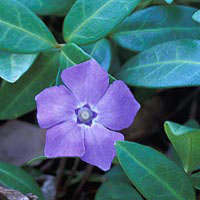Periwinkle
 © Martin Wall
© Martin WallHow It Works
There are two classes of active compounds in lesser periwinkle—alkaloids and tannins. The major alkaloid is known as vincamine. A closely related semisynthetic derivative of vincamine most widely used as medicine is known as ethyl-apovincaminate or vinpocetine. It has vasodilating, blood thinning, and memory-enhancing actions. It has been shown in double-blind studies to help alleviate a type of dementia known as vascular dementia, in which the arteries supplying blood to the brain develop atherosclerotic plaques.3, 4, 5 A double-blind study found that vincamine can help people with Alzheimer’s disease,6 while one open study did not.7 Vinpocetine has also been found to prevent the decline in short-term memory induced by the anti-anxiety benzodiazepine drug flunitrazepam in one preliminary study.8 Further study is needed to determine whether vinpocetine would be a helpful adjunct to use of benzodiazepines.
One double-blind study found that high amounts of vinpocetine (60 mg per day) could have a beneficial effect on hearing loss due to aging (presbyacusis).9 A preliminary study concluded that supplementation with ethyl-apovincaminate (a vinca alkaloid) may reduce symptoms of tinnitus (ringing in the ears) due to impaired blood flow to the inner ear.10 One review of the use of vinpocetine in people who have suffered strokes found that the only double-blind study did not show efficacy,11 though previous uncontrolled studies have suggested there might be a benefit.12, 13
Vinpocetine tends to act as a calcium-chelating agent. One uncontrolled study found that use of vinpocetine for 3 to 12 months could eliminate calcium buildup in people undergoing dialysis.14 Further research is needed to determine whether this could be helpful in other conditions associated with excess calcium, or whether vinpocetine might interfere with calcium’s beneficial actions.
One double-blind and one preliminary study have found that brovincamine, a compound closely related to vinpocetine, was helpful in people with chronic glaucoma.15, 16 Until studies have been conducted using actual vinpocetine, it is unknown whether it would be as effective as brovincamine.
Crude periwinkle also contains tannins. These make it a mild astringent. It may relieve pain from canker sores or sore throats, according to traditional use. Clinical trials have not been conducted to confirm this.
How to Use It
The amount of vinpocetine used in most studies is 15 mg one to three times per day.17 Vinpocetine should be taken with food, as it has been shown to be better absorbed with meals than when taken away from meals.18 It may take three to six weeks before any improvement is noted.19
A tincture can be taken in the amount of 1 to 2 ml three times per day.20 A tea can be made by infusing 1 teaspoon of herb into a cup of water for 10 to 15 minutes; three cups per day should be drunk.21 Research has not been conducted to determine whether a tincture or a tea provides enough periwinkle compounds to have the same effects as vinpocetine.
Copyright © 2024 TraceGains, Inc. All rights reserved.
Learn more about TraceGains, the company.
The information presented by TraceGains is for informational purposes only. It is based on scientific studies (human, animal, or in vitro), clinical experience, or traditional usage as cited in each article. The results reported may not necessarily occur in all individuals. Self-treatment is not recommended for life-threatening conditions that require medical treatment under a doctor's care. For many of the conditions discussed, treatment with prescription or over the counter medication is also available. Consult your doctor, practitioner, and/or pharmacist for any health problem and before using any supplements or before making any changes in prescribed medications. Information expires December 2024.















